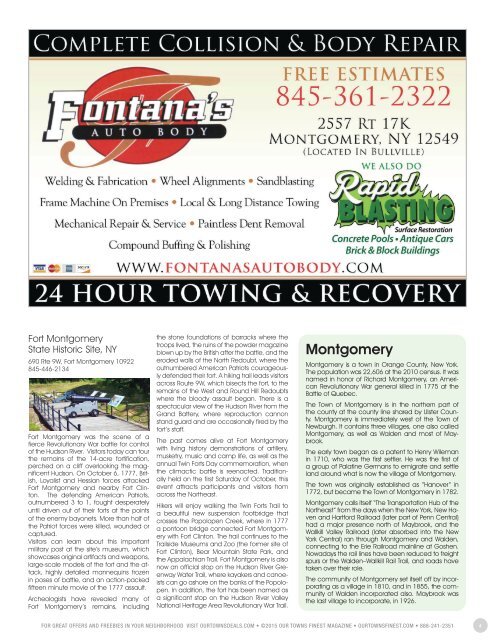Montgomery / Walden / Pine Bush, NY 12549
Our Towns Finest Magazine in Montgomery / Walden / Pine Bush, NY 12549
Our Towns Finest Magazine in Montgomery / Walden / Pine Bush, NY 12549
Create successful ePaper yourself
Turn your PDF publications into a flip-book with our unique Google optimized e-Paper software.
Fort <strong>Montgomery</strong><br />
State Historic Site, <strong>NY</strong><br />
690 Rte 9W, Fort <strong>Montgomery</strong> 10922<br />
845-446-2134<br />
Fort <strong>Montgomery</strong> was the scene of a<br />
fierce Revolutionary War battle for control<br />
of the Hudson River. Visitors today can tour<br />
the remains of the 14-acre fortification,<br />
perched on a cliff overlooking the magnificent<br />
Hudson. On October 6, 1777, British,<br />
Loyalist and Hessian forces attacked<br />
Fort <strong>Montgomery</strong> and nearby Fort Clinton.<br />
The defending American Patriots,<br />
outnumbered 3 to 1, fought desperately<br />
until driven out of their forts at the points<br />
of the enemy bayonets. More than half of<br />
the Patriot forces were killed, wounded or<br />
captured.<br />
Visitors can learn about this important<br />
military post at the site’s museum, which<br />
showcases original artifacts and weapons,<br />
large-scale models of the fort and the attack,<br />
highly detailed mannequins frozen<br />
in poses of battle, and an action-packed<br />
fifteen minute movie of the 1777 assault.<br />
Archeologists have revealed many of<br />
Fort <strong>Montgomery</strong>’s remains, including<br />
the stone foundations of barracks where the<br />
troops lived, the ruins of the powder magazine<br />
blown up by the British after the battle, and the<br />
eroded walls of the North Redoubt, where the<br />
outnumbered American Patriots courageously<br />
defended their fort. A hiking trail leads visitors<br />
across Route 9W, which bisects the fort, to the<br />
remains of the West and Round Hill Redoubts<br />
where the bloody assault began. There is a<br />
spectacular view of the Hudson River from the<br />
Grand Battery, where reproduction cannon<br />
stand guard and are occasionally fired by the<br />
fort’s staff.<br />
The past comes alive at Fort <strong>Montgomery</strong><br />
with living history demonstrations of artillery,<br />
musketry, music and camp life, as well as the<br />
annual Twin Forts Day commemoration, when<br />
the climactic battle is reenacted. Traditionally<br />
held on the first Saturday of October, this<br />
event attracts participants and visitors from<br />
across the Northeast.<br />
Hikers will enjoy walking the Twin Forts Trail to<br />
a beautiful new suspension footbridge that<br />
crosses the Popolopen Creek, where in 1777<br />
a pontoon bridge connected Fort <strong>Montgomery</strong><br />
with Fort Clinton. The trail continues to the<br />
Trailside Museums and Zoo (the former site of<br />
Fort Clinton), Bear Mountain State Park, and<br />
the Appalachian Trail. Fort <strong>Montgomery</strong> is also<br />
now an official stop on the Hudson River Greenway<br />
Water Trail, where kayakers and canoeists<br />
can go ashore on the banks of the Popolopen.<br />
In addition, the fort has been named as<br />
a significant stop on the Hudson River Valley<br />
National Heritage Area Revolutionary War Trail.<br />
<strong>Montgomery</strong><br />
<strong>Montgomery</strong> is a town in Orange County, New York.<br />
The population was 22,606 at the 2010 census. It was<br />
named in honor of Richard <strong>Montgomery</strong>, an American<br />
Revolutionary War general killed in 1775 at the<br />
Battle of Quebec.<br />
The Town of <strong>Montgomery</strong> is in the northern part of<br />
the county at the county line shared by Ulster County.<br />
<strong>Montgomery</strong> is immediately west of the Town of<br />
Newburgh. It contains three villages, one also called<br />
<strong>Montgomery</strong>, as well as <strong>Walden</strong> and most of Maybrook.<br />
The early town began as a patent to Henry Wileman<br />
in 1710, who was the first settler. He was the first of<br />
a group of Palatine Germans to emigrate and settle<br />
land around what is now the village of <strong>Montgomery</strong>.<br />
The town was originally established as “Hanover” in<br />
1772, but became the Town of <strong>Montgomery</strong> in 1782.<br />
<strong>Montgomery</strong> calls itself “The Transportation Hub of the<br />
Northeast” from the days when the New York, New Haven<br />
and Hartford Railroad (later part of Penn Central)<br />
had a major presence north of Maybrook, and the<br />
Wallkill Valley Railroad (later absorbed into the New<br />
York Central) ran through <strong>Montgomery</strong> and <strong>Walden</strong>,<br />
connecting to the Erie Railroad mainline at Goshen.<br />
Nowadays the rail lines have been reduced to freight<br />
spurs or the <strong>Walden</strong>–Wallkill Rail Trail, and roads have<br />
taken over their role.<br />
The community of <strong>Montgomery</strong> set itself off by incorporating<br />
as a village in 1810, and in 1855, the community<br />
of <strong>Walden</strong> incorporated also. Maybrook was<br />
the last village to incorporate, in 1926.<br />
for great offers and freebies in your neighborhood visit ourtownsdeals.com • ©2015 our towns finest magazine • ourtownsfinest.com • 888-241-2351 4

















